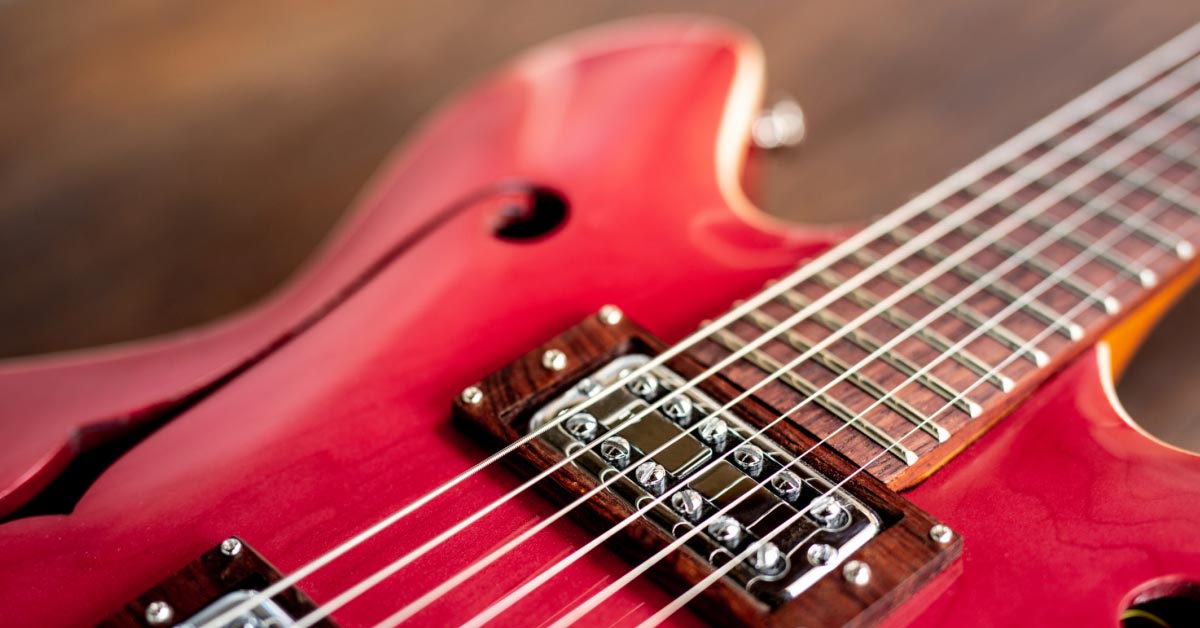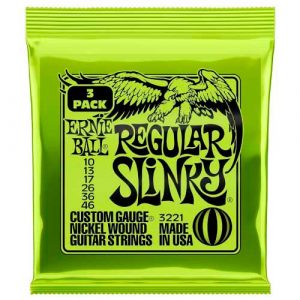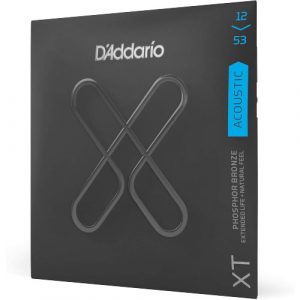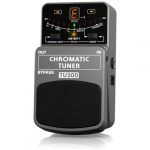Embarking on your guitar-playing journey is an exhilarating adventure filled with aspirations of rock stardom and a touch of bewilderment with terms such as “gauge” and “tension.” The challenge intensifies when asking the question “what are the best guitar strings for a beginners”. However, there’s no need to worry! This guide aims to simplify the complex world of guitar strings, assisting you in making a knowledgeable decision that will ensure your path to mastering the guitar is as seamless as a blues solo.
Understanding Guitar Strings
Before diving into the nitty-gritty of materials and gauges, let’s take a quick look at what you’re actually putting on your guitar. Strings can be as varied as the songs you’re itching to play. They differ in material, thickness, and even the shape of their core. Whether you have an acoustic, electric, or classical guitar, there’s a string set that’s just right for you. Think of it as matchmaking but for your guitar.
Guitar String Materials
Nylon Strings
Soft on the fingers and warm in tone, nylon strings are the go-to for classical and flamenco guitars. They’re like the comforting bowl of soup on a cold day – easy to get along with and good for the soul (and your fingertips).
Nickel Strings
When answering the question “what are the best guitar strings for a beginner?”, the versatile heroes of the electric guitar world, ideal for genres ranging from jazz to heavy metal. They act like chameleons of the string family, effortlessly adjusting to whatever musical mood you’re in.
Gauge: The Thickness of Strings
Gauge is basically the size of your strings, and it affects everything from how your guitar plays to the sound it makes. Light gauge strings are like feathers – easy to play with, producing a bright sound. Heavy gauge strings, on the other hand, are the weightlifters – tougher to press down but rewarding with a richer sound. Medium gauge? They’re the Goldilocks of strings, just right for most beginners.
Coated vs. Uncoated Strings
In discussing the durability of your guitar strings, think of coated strings as smartphones equipped with protective cases – they endure longer and maintain their freshness, yet they might feel different under your fingers.
Conversely, uncoated strings offer a direct, unfiltered interaction with your guitar, though they may require replacements more often. This presents a balance between longevity and genuine playing experience, especially when looking at what are the best guitar strings for a beginner.
String Core Types
When you peek inside a guitar string, you’ll find its core, which isn’t just a fun centre like in chocolates. Strings can have a round core or a hex core. Round core strings are the old souls of the guitar world, offering a vintage vibe with a more flexible feel.
Just as classic jeans never fall out of fashion, hex core strings are the modern, fitted jeans of the guitar world, known for their brighter sound and more consistent tuning. For those asking, “what are the best guitar strings for a beginner,” hex core strings are often recommended.
They provide ease of handling and the extra stability crucial for beginners. This characteristic establishes hex core strings as the answer to “what are the best guitar strings for a beginner,” enabling a more seamless entry into guitar playing.
Tension Levels
Think of tension as the string’s tightness. Low tension strings are like a relaxed Sunday morning – easy to press and gentle on the fingers. High tension strings require a bit more muscle, like opening a jar of pickles, but reward you with a louder, more pronounced sound. For beginners, low to medium tension strings are usually the best bet, offering a nice balance between playability and sound quality.
Scale Length and Its Impact
Scale length might sound like something from a physics class, but it’s actually pretty straightforward. It’s the distance between the nut and the bridge of your guitar, and it influences how your strings feel and sound. A longer scale length means more tension, resulting in a brighter tone. Shorter scale lengths are easier on the fingers. For beginners, a guitar with a standard scale length (about 25.5″ for electric and 24.75″ for acoustic) is a safe starting point, giving you a balanced experience.
Choosing Strings for Acoustic Guitars
For acoustic guitar newbies, the world of strings is your oyster. Phosphor bronze strings are a great starting point, offering a warm, rich tone that’s as comforting as your favorite sweater. They’re versatile and work well for a variety of musical styles. If you’re after something brighter, try 80/20 bronze strings; they’re like adding a splash of color to your sound. And remember, a light gauge is your friend as you start your strumming journey.
Choosing Strings for Electric Guitars
Diving into the world of electric guitars and searching for “what are the best guitar strings for a beginner” often guides newcomers towards the benefits of nickel-plated steel strings. Recognized as the best guitar strings for a beginner, they offer a harmonious blend of balanced sound and crisp tone, making them suitable for a diverse array of musical genres, from jazz to rock. Such adaptability makes them an ideal choice for beginners looking for a seamless introduction to their musical adventure.
Should your musical inclinations veer towards blues or rock, pure nickel strings could become your favorite, delivering a warmer, retro vibe. Similarly, opting for a lighter gauge with both electric and acoustic guitars can make the initial learning phase significantly smoother.
The weight/lightness and resonance of your guitar will also be a factor when looking at guitar strings. Guitars that are built for heavy metal music will perform better with lighter gauge high strings and heavier gauge lower strings.
Choosing Strings for Classical Guitars
Entering the classical realm, nylon strings are your sole companions, but they come in different flavors. Normal tension nylon strings are perfect for beginners, offering ease of playability and a gentle introduction to your fingers.
If you’re feeling adventurous and want a bit more volume and resistance, high tension strings can be your next step. Remember, classical guitars are about grace and warmth, and the right strings can make your guitar sing like a morning bird.
How to Read String Packaging Labels
For those wondering “what are the best guitar strings for a beginner,” deciphering the labels on string packages can seem as daunting as interpreting hieroglyphics at first glance. However, there’s no cause for concern! Understanding these labels becomes straightforward once you familiarize yourself with the basic concepts.
Gauge numbers, such as .010-.046, reveal the thickness of the strings in inches, indicating the range from the thinnest to the thickest in the set, essential information for beginners selecting their ideal strings.
Materials are often listed as “Phosphor Bronze” or “Nickel-Plated Steel,” telling you what the strings are made of. Some packs also mention tension levels or descriptors like “light” or “medium.” Consider this your cheat sheet to understanding what’s inside the pack without needing a Rosetta Stone.
When to Change Guitar Strings
Guitar strings, much like that forgotten slice of pizza in the fridge, aren’t meant to last indefinitely. The moment your strings begin to emit a dull sound, struggle with maintaining tune, or exhibit clear signs of deterioration (such as rust or fading), it’s a signal for a replacement.
Changing guitar strings is comparable to personal hygiene practices, like brushing your teeth, albeit on a less regular basis. For those questioning “what are the best guitar strings for a beginner,” a good rule of thumb is to plan for a string replacement every 3 to 6 months. Yet, paying attention to your guitar’s response is vital, as it will signal the best timing for a string update.
Step-by-Step Guide to Changing Guitar Strings
Changing guitar strings is a rite of passage, like learning to tie your shoes. Here’s the cliff notes version:
- Loosen the old strings and remove them. This is the only time when making your guitar “un-stringed” is acceptable.
- Clean your guitar now that it’s string-free. It’s like finding hidden treasure under the couch cushions.
- Thread the new string through the bridge (acoustic) or tailpiece (electric), then pull it snugly up to the tuning peg.
- Wind the string around the tuning peg, making sure it’s tight and secure. This is not the time for sloppy knots.
- Tune up using a tuner, your phone, or your ear (if you’re feeling brave).
- Stretch the strings gently to help them settle in. Think of it as a mini yoga session for your strings.
Tuning Your New Strings
New strings are like excited puppies; they need a little time to settle down. After you’ve put them on and tuned them up, you’ll likely notice they go out of tune quickly. This is normal. Strings need to stretch and adjust to their new life on your guitar. Give them a good stretch, retune, and repeat a few times. They’ll soon hold their tuning like a pro, ready for your next musical adventure.
The Role of String Action
String action, defined as the distance between the strings and the fretboard, is vital for the playability of a guitar, especially when asking the question – what are the best guitar strings for a beginner.
If the action is too high, playing the guitar can feel like an intense workout. Conversely, if it’s too low, you might encounter more buzzing sounds than you would at a bee convention. While the string gauge can influence the action, the overall setup of the guitar plays a more significant role.
If pressing down on the strings feels overly challenging, opting for a lighter gauge or having your guitar professionally adjusted to lower the action can make a considerable difference. It’s akin to finding the ideal height for your chair; it needs to be perfectly tailored to your comfort and playing style.
Common Mistakes to Avoid When Choosing Strings
In the quest for the perfect strings, beginners often fall into a few traps:
Ignoring gauge
Don’t jump into heavy strings too soon; start light and work your way up.
Overlooking material: The right material can make a big difference in sound and feel. Don’t choose based on what your favorite artist uses without trying out what works for you.
Learning More About Guitar Strings
The journey doesn’t stop here. Dive into books like “The Guitar Handbook” for a deep dive into all things guitar, including strings. Websites like Ultimate Guitar offer great forums for advice, and YouTube channels like JustinGuitar are goldmines for visual learners.
Choosing the best guitar strings as a beginner doesn’t have to be a daunting task. Armed with a bit of knowledge and a willingness to experiment, you’ll find the strings that make your guitar playing journey a joy. Remember, every guitarist started somewhere, and the right strings are out there waiting for you.
The Ultimate Guide to Choosing Guitar Strings for Beginners
Starting your musical adventure is exciting, particularly with a guitar in your hands and aspirations in your heart. However, before you play your inaugural chord, you face an essential choice: choosing the appropriate guitar strings.
If you’re pondering ‘what are the best guitar strings for a beginner,’ you’ve arrived at the ideal place. Together, we’ll demystify this selection process, guaranteeing your journey is as seamless as the tunes you aspire to perform.
Beginner Guitar String Guide: Your First Step
Navigating the quest to identify “what are the best guitar strings for a beginner” can feel like navigating a complex labyrinth. However, rest assured, guidance is at hand. No matter if you’re drawn to acoustic, electric, or classical guitars, understanding the basics is essential.
Each type of guitar harmonizes optimally with certain strings, and acknowledging this distinction is the first step on your journey to mastery. This understanding is pivotal in answering “what are the best guitar strings for a beginner,” setting the stage for a successful musical adventure.
Acoustic vs Electric Strings: Knowing the Difference
Acoustic guitar strings are typically made from bronze or phosphor bronze, offering a bright and resonant sound perfect for those campfire songs or soulful melodies. Electric guitar strings, on the other hand, lean towards materials like nickel-plated steel, giving you that crisp, clear tone rock and roll dreams are made of.
Best String Gauge for Beginners: Finding Your Fit
When exploring “what are the best guitar strings for a beginner,” it’s essential to consider string gauge, which measures the strings’ thickness. The goal is to discover an ideal balance: strings that are neither excessively thick nor too thin.
Light gauge strings stand out as the optimal choice, providing an effortless playing experience that won’t overly strain your fingertips. Consider them the training wheels of guitar strings, offering the necessary support until you’re prepared to venture out on your own musical journey.
Nylon Strings for Classical Guitar: A Gentle Touch
If your musical heart beats for classical tunes, nylon strings are your soulmates. Gentle on the fingers and warm in tone, they make learning those intricate flamenco or classical pieces a tad less daunting.
Changing Guitar Strings Tips: Keeping It Fresh
Changing strings might seem like a chore, but it’s a vital skill every guitarist should master. Regular changes keep your sound bright and your playing smooth. Plus, it’s a great way to get intimate with your instrument, understanding its quirks and features.
String Material Sound Quality: Crafting Your Sound
The material of your strings plays a pivotal role in shaping your guitar’s voice. Bronze strings sing with a bright, clear tone, ideal for strumming your way through folk and country. Nickel-plated strings, with their crisp sound, will have you riffing through rock and blues like a pro.
Easy to Play Guitar Strings: Comfort First
As a beginner, your focus should be on learning, not on battling your instrument. Light gauge strings, with their flexibility and gentler touch, reduce finger fatigue, letting you play longer and learn faster.
Long-Lasting Guitar Strings: Playing the Long Game
Opting for coated strings may require a slightly higher initial investment, but their durability against dirt and corrosion translates to less frequent string changes.
Choosing the right guitar strings is similar to picking a reliable backpack for a long hike, ensuring your journey is uninterrupted by nuisances. In answering the question, “what are the best guitar strings for a beginner,” coated strings emerge as a top choice. They provide durability and steady performance, qualities that greatly improve the learning process for beginners.
Guitar Tuning Stability: Stay in Tune
Nothing disrupts learning like a guitar that won’t stay in tune. Quality strings, matched with proper setup and maintenance, ensure your guitar remains in harmony, letting you focus on your playing rather than constant tuning adjustments.
String Tension and Playability: Striking a Balance
The tension of your strings affects both the feel of your guitar and the sound it produces. Medium tension strings offer a balanced approach, giving you a comfortable playing experience without sacrificing tonal quality. It’s about finding the sweet spot where playability meets sound perfection.
Wrapping up what are the best guitar strings for a beginner
When it comes to figuring out “what are the best guitar strings for a beginner,” it’s not as simple as grabbing the first set off the shelf. It requires familiarizing yourself with your instrument, understanding your musical tastes, and making sure you’re comfortable while playing.
Whether it’s the soft caress of nylon strings suited for classical enthusiasts or the vivid, warm tones of phosphor bronze strings for aspiring folk musicians, the strings you choose lay the foundation for your musical expedition.
Remember, every guitarist started where you are now. With the right strings under your fingers, you’re not just playing music; you’re creating magic. So, go ahead, string up your guitar, and let the melodies flow. Your musical adventure is just beginning.
FAQs About what are the best Guitar Strings for a Beginner
Can I mix and match different types of strings?
Although there are various choices available, it’s recommended for beginners to be consistent in their selection of strings. Choosing “what are the best guitar strings for a beginner” and remaining loyal to that set can significantly simplify the learning process.
How often should I change my strings?
It varies, but aim for every 3-6 months or when they start sounding dull or are hard to keep in tune.
What are the best guitar strings for a beginner?
Beginners in search of the best guitar strings should prioritize options that provide ease of play and comfort. Light gauge strings are often recommended due to their playability. Depending on the guitar type, the material of the strings can vary: nylon is ideal for classical guitars, phosphor bronze suits acoustic guitars, and nickel-plated steel is preferred for electric guitars.
How often should I change my guitar strings?
Change your strings every 3 to 6 months, depending on how often you play. Look out for signs like dull sound, difficulty tuning, or visible wear and tear as indicators that it’s time for a change.
Can I mix different types of strings on my guitar?
While it’s possible, it’s best to stick with a consistent set when you’re starting out to keep the learning curve manageable and maintain balanced sound and tension.
How do I know which gauge of strings to choose?
Start with light gauge strings for easier playability. As you develop your playing technique and preferences, you can experiment with medium or heavy gauges to find what suits you best.
What’s the difference between coated and uncoated strings?
Coated strings have a longer life span and resist dirt and moisture, but they might feel different to the touch. Uncoated strings offer a more traditional feel and sound but may require more frequent changes.
What should I consider when choosing strings for an acoustic guitar?
For acoustic guitars, consider strings that enhance the guitar’s natural sound. Phosphor bronze strings are popular for their warm, rich tone, while 80/20 bronze strings offer a brighter sound.
What’s the best way to tune new strings?
New strings need to stretch and settle in. Tune them up, stretch them gently, then retune. Repeat this process a few times until they maintain their tuning stability.
Does the string material matter?
Yes, the material affects both the sound and feel of the strings. Nylon strings provide a softer feel ideal for classical music, steel strings produce a brighter sound for acoustic guitars, and nickel strings are versatile for various electric guitar styles.
How do string gauges affect playability?
Lighter gauges are easier to press and bend, making them ideal for beginners. Heavier gauges provide a fuller sound but require more finger strength to play and can be harder on the fingers.
What is string action, and how do strings affect it?
String action refers to the height of the strings above the fretboard. While the gauge can influence action, adjustments are typically made through the guitar setup rather than string choice alone. However, lighter gauge strings can feel easier to play for beginners due to lower tension.









